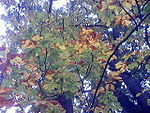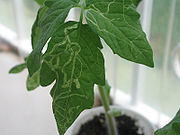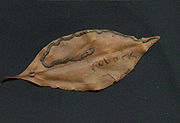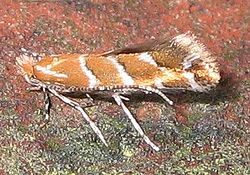
Leaf miner
Encyclopedia




Larva
A larva is a distinct juvenile form many animals undergo before metamorphosis into adults. Animals with indirect development such as insects, amphibians, or cnidarians typically have a larval phase of their life cycle...
e of many different species of insect
Insect
Insects are a class of living creatures within the arthropods that have a chitinous exoskeleton, a three-part body , three pairs of jointed legs, compound eyes, and two antennae...
which live in and eat the leaf
Leaf
A leaf is an organ of a vascular plant, as defined in botanical terms, and in particular in plant morphology. Foliage is a mass noun that refers to leaves as a feature of plants....
tissue
Biological tissue
Tissue is a cellular organizational level intermediate between cells and a complete organism. A tissue is an ensemble of cells, not necessarily identical, but from the same origin, that together carry out a specific function. These are called tissues because of their identical functioning...
of plants. The vast majority of leaf-mining insects are moth
Moth
A moth is an insect closely related to the butterfly, both being of the order Lepidoptera. Moths form the majority of this order; there are thought to be 150,000 to 250,000 different species of moth , with thousands of species yet to be described...
s (Lepidoptera
Lepidoptera
Lepidoptera is a large order of insects that includes moths and butterflies . It is one of the most widespread and widely recognizable insect orders in the world, encompassing moths and the three superfamilies of butterflies, skipper butterflies, and moth-butterflies...
), sawflies (Symphyta
Sawfly
Sawfly is the common name for insects belonging to suborder Symphyta of the order Hymenoptera. Sawflies are distinguishable from most other Hymenoptera by the broad connection between the abdomen and the thorax, and by their caterpillar-like larvae...
) and flies (Diptera
Diptera
Diptera , or true flies, is the order of insects possessing only a single pair of wings on the mesothorax; the metathorax bears a pair of drumstick like structures called the halteres, the remnants of the hind wings. It is a large order, containing an estimated 240,000 species, although under half...
), though some beetle
Beetle
Coleoptera is an order of insects commonly called beetles. The word "coleoptera" is from the Greek , koleos, "sheath"; and , pteron, "wing", thus "sheathed wing". Coleoptera contains more species than any other order, constituting almost 25% of all known life-forms...
s and wasp
Wasp
The term wasp is typically defined as any insect of the order Hymenoptera and suborder Apocrita that is neither a bee nor an ant. Almost every pest insect species has at least one wasp species that preys upon it or parasitizes it, making wasps critically important in natural control of their...
s also exhibit this behavior.
Like Woodboring beetle
Woodboring beetle
The term woodboring beetle encompasses many species and families of beetles whose larval or adult forms eat and destroy wood . Larval stages of some are commonly known as woodworms.-Invasion and control:...
s, leaf miners are protected from many predators and plant defenses by feeding within the tissues of the leaves themselves, selectively eating only the layers that have the least amount of cellulose
Cellulose
Cellulose is an organic compound with the formula , a polysaccharide consisting of a linear chain of several hundred to over ten thousand β linked D-glucose units....
. When attacking Quercus robur (English oak), they also selectively feed on tissues containing lower levels of tannin
Tannin
A tannin is an astringent, bitter plant polyphenolic compound that binds to and precipitates proteins and various other organic compounds including amino acids and alkaloids.The term tannin refers to the use of...
, a deterrent chemical produced in great abundance by the tree
Tree
A tree is a perennial woody plant. It is most often defined as a woody plant that has many secondary branches supported clear of the ground on a single main stem or trunk with clear apical dominance. A minimum height specification at maturity is cited by some authors, varying from 3 m to...
.
The precise pattern formed by the feeding tunnel is very often diagnostic for which kind of insect is responsible, sometimes even to genus
Genus
In biology, a genus is a low-level taxonomic rank used in the biological classification of living and fossil organisms, which is an example of definition by genus and differentia...
level. The mine often contains frass
Frass
Frass is the fine powdery material phytophagous insects pass as waste after digesting plant parts. It causes plants to excrete chitinase due to high chitin levels, it is a natural bloom stimulant, and has high nutrient levels. Frass is known to have abundant amoeba, beneficial bacteria, and fungi...
, or droppings, and the pattern of frass deposition, mine shape and host plant identity are useful to determine the species of leaf miner. A few mining insects utilise other parts of a plant, such as the surface of a fruit
Fruit
In broad terms, a fruit is a structure of a plant that contains its seeds.The term has different meanings dependent on context. In non-technical usage, such as food preparation, fruit normally means the fleshy seed-associated structures of certain plants that are sweet and edible in the raw state,...
.
Some patterns of leaf variegation are part of a defense strategy employed by plants to deceive adult leaf miners into thinking that the leaf has already been predated.
Relationship with humans

Crop (agriculture)
A crop is a non-animal species or variety that is grown to be harvested as food, livestock fodder, fuel or for any other economic purpose. Major world crops include maize , wheat, rice, soybeans, hay, potatoes and cotton. While the term "crop" most commonly refers to plants, it can also include...
and garden
Garden
A garden is a planned space, usually outdoors, set aside for the display, cultivation, and enjoyment of plants and other forms of nature. The garden can incorporate both natural and man-made materials. The most common form today is known as a residential garden, but the term garden has...
plants, and can be difficult to control with insecticide
Insecticide
An insecticide is a pesticide used against insects. They include ovicides and larvicides used against the eggs and larvae of insects respectively. Insecticides are used in agriculture, medicine, industry and the household. The use of insecticides is believed to be one of the major factors behind...
sprays as they are protected inside the plant's leaves. Spraying the infected trees/plants with Spinosad
Spinosad
Spinosad is a new chemical class of insecticides that are registered by the United States Environmental Protection Agency to control a variety of insects...
, an organic insecticide, will control the leaf miner. Spinosad does not kill on contact but must be ingested by the leaf miner. Two or three applications may be needed in a season, being careful not to spray when bees are around.
Leaf miner infection can be reduced or prevented by planting trap crop
Trap crop
A trap crop is a plant that attracts agricultural pests, usually insects, away from nearby crops. This form of companion planting can save the main crop from decimation by pests without the potential issues and controversy involved in using pesticides....
s near the plants to be protected. For example, lambsquarter, columbine
Aquilegia
Aquilegia is a genus of about 60-70 species of perennial plants that are found in meadows, woodlands, and at higher altitudes throughout the Northern Hemisphere, known for the spurred petals of their flowers.-Etymology:The genus name Aquilegia is derived from the Latin word for eagle , because...
, and velvetleaf
Velvetleaf
Velvetleaf is a common name used for plants with soft-haired leaves:* Abutilon theophrasti * Limnocharis flava Buchenau...
will distract leaf miners, drawing them to those plants and therefore reducing the incidence of attack on nearby crops. This is a method of companion planting
Companion planting
Companion planting is the planting of different crops in proximity , on the theory that they assist each other in nutrient uptake, pest control, pollination, and other factors necessary to increasing crop productivity...
.
See also
- AgromyzidaeAgromyzidaeThe family Agromyzidae is commonly referred to as the leaf-miner flies, for the feeding habit of larvae, most of which are leaf miners on various plants....
(Leaf miner flies) - DouglasiidaeDouglasiidaeThe small Lepidopteran family Douglasiidae includes several species of moths whose adults are collectively called Douglas moths and whose larvae are leaf miners...
(including Tinagma, the largest genusGenusIn biology, a genus is a low-level taxonomic rank used in the biological classification of living and fossil organisms, which is an example of definition by genus and differentia...
of Douglasiidae) - GracillariidaeGracillariidaeGracillariidae is an important family of insects in the order Lepidoptera and the principal family of leaf miners that includes several economic, horticultural or recently invasive pest species such as the horse-chestnut leaf miner, Cameraria ohridella....
- NepticulidaeNepticulidaeNepticulidae is a family of very small moths with a worldwide distribution. They are characterised by eyecaps over the eyes . These pigmy moths or midget moths, as they are commonly known, include the smallest of all living moths, with a wingspan that can be as little as 3 mm...
- Horse-chestnut leaf minerHorse-chestnut leaf minerThe horse-chestnut leaf miner is a leaf-mining moth of the Gracillariidae family. The horse-chestnut leaf miner was first observed in Macedonia in 1984, and was described as a new species in 1986. Its larvae are leaf miners on the Common Horse-chestnut...
(Cameraria ohridella) - TenthredinidaeTenthredinidaeThe Tenthredinidae is the largest family of sawflies, with well over 6000 species worldwide. Larvae are typically herbivores and feed on the foliage of trees and shrubs, with occasional exceptions that are leaf miners, stem borers, or gall makers. The larvae of externally feeding species resemble...
(some species) - TischerioideaTischerioideaTischerioidea is the superfamily of "trumpet" leaf miner moths.This is one candidate as the sister group of the bulk of Lepidoptera, the Ditrysia , and they have a monotrysian type of female reproductive system...
(Trumpet leaf-miner moths) - FolivoreFolivoreIn zoology, a folivore is a herbivore that specializes in eating leaves. Mature leaves contain a high proportion of hard-to-digest cellulose, less energy than other types of foods, and often toxic compounds. For this reason folivorous animals tend to have long digestive tracts and slow metabolisms....
External links
- British leafminers - many of which are distributed widely across Europe.
- Leafminers of Europe - covers over 1800 leafmining insect species.
- leafminers of southeastern U.S. woody ornamentals on the UFUniversity of FloridaThe University of Florida is an American public land-grant, sea-grant, and space-grant research university located on a campus in Gainesville, Florida. The university traces its historical origins to 1853, and has operated continuously on its present Gainesville campus since September 1906...
/ IFASInstitute of Food and Agricultural SciencesThe University of Florida’s Institute of Food and Agricultural Sciences is a federal-state-county partnership dedicated to developing knowledge in agriculture, human and natural resources, and the life sciences, and enhancing and sustaining the quality of human life by making that information...
Featured Creatures Web site - Liriomyza trifolii, American serpentine leafminer
- Liriomyza sativae, vegetable leafminer
- Phyllocnistis citrella, citrus leafminer
- CISR: Citrus Leaf Miner Center for Invasive Species Research page on Citrus Leaf Miner

